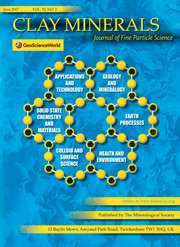Article contents
Clay Minerals as Catalysts
Introduction
Published online by Cambridge University Press: 14 March 2018
Extract
The industrial uses of clay minerals as catalysts date from the early 'thirties. The application of catalysis to the thermal cracking of oil started in about 1931; pre-heated oil was passed downwards through fixed beds of granular catalyst, often attapulgite, under pressure (80 lb. per sq. in.) and at about 900°F., as in the Houdry and Hydroforming systems. The catalyst had to be periodically burned off to regenerate it, and was reintroduced at the top of the reaction column. An improvement on this static process came when the granulated catalyst was kept moving counter current to the pre-heated oil. This led about 1939 to the fluid-flow method of catalysis in which powdered catalysts are used in a fluid, free-flowing condition, circulated by the air-rift method well-known in the movement of liquids.
- Type
- Research Article
- Information
- Copyright
- Copyright © The Mineralogical Society of Great Britain and Ireland 1948
- 1
- Cited by


